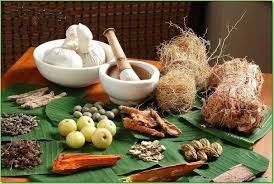
Ayurvedic Guidelines for Holistic Living
Ayurveda prescribes three major guidelines for Healthy Living. They are Dinacharya, Ritucharya & Brahmacharya.
Dinacharya
One should get up early in the morning at 0430 AM , the time prescribed for Meditation. After brushing the teeth, one should take an oil bath.
Oil, preferably coconut oil, should be put all over the body and one should relax for 30-60 minutes for the oil to sink in. Oil Bath is known in Ayurveda as Abhyanga. Because of the oil bath, you will get proper sleep. The body becomes fresh. The body is fortified and becomes cool. Oil will take care of all the diseases of the scalp. It will prevent hair loss. The hair becomes blacker and more healthy. After Abhyanga, one should do exercise. Exercise will increase the digestive capacity and obesity will be controlled. After doing exercise ( Yoga exercises are the best ), one should massage the body mildly. One should not do excess exercise. Excess exercise can result in weakness, thirst, fever and vomiting. Mild massage can destroy phlegm and reduce fat.
Taking oil bath daily increases the digestive fire. It will increase the sexual capacity. More energy and strength will be imparted by an oil bath. Physical weakness will disappear. One should pour only cold water over the head . Hot water bath is ideal for the rest of the body.
Ritucharya
Western system of Astrology which follows the Tropical Zodiac identifies four major seasons - Spring, Summer, Autumn and Winter.
From March 21 we have the beginning of summer, after the Spring Equinox. From June 21 we have autumn, after the Summer Solstice. From Sept 22 we have Winter, after the Autumnal Equinox and after Dec 22, which is the pagan festival of Winter Solstice, we have Spring.
The Indian system of Astrology which follows the Sidereal Zodiac identifies six major seasons known as Rithus. Two months constitute a Rithu. ( Tau Dwau Rithu ).
They are Vasantha ( Chaitra & Vaishakha ), Greeshma ( Jyeshta & Ashada ), Varsha ( Sravana & Karthika ), Sharath ( Bhadrapada & Aswina ) & Hemantha ( Margasheersha & Pausha ) and Sisira ( Maagha & Phalguna).

During Sharath Rithu,
Pitta will be more.
During Hemanta Rithu,
Kapha will be more.
During Varsha, Vata will be more.
Uttarayana ( the Northern Progress of the Sun ) involve the six solar sidereal months from Capricorn to Cancer. During this phase, one should take abundant fruits like pomegranate, water melon, orange, grapes and tender coconut water. This phase is known as Adana Kala because much strength is lost from the body due to the hot season. Plantains and bananas should also be taken in. Rice, wheat, gooseberry ( which is a rich source of Vitamin C ), pineapple, mangoes, cashew, groundnut, carrot, pumpkin,honey, milk and leafy vegetables should also be consumed.
Dakshinayana ( the Southern Progress of the Sun ) involve the six solar sidereal months from Cancer to Capricorn. This phase is known as Visarga Kala , as this is a period which augments physical strength. Bittergourd, gooseberry, chilli, wheat, honey, rice and vegetables can be taken in during this period.
Brahmacharya means to roam in Brahman, the Absolute, to embrace none but Him.
High Emotional Quotient and Spiritual Quotient are also the boons of Brahmacharya.
Semen consists of the triune properties of Heat ( Tejas ), Light ( Ojas) and Electricity ( Vidyut ). Sublimation of this vital fluid can result in increased longevity. It will fortify the Immune system and body can be saved from wrinkles. Intuition and the discriminative intellect will function more during celibacy. Hence controlled Brahmacharya is a must for Healthy Living.
For every disease there is Pathya. The Ayurvedic Physician will say dont take such and such food. Foods that are to be avoided in general are spicy foods, alcohol, non veg like beef, eggs and fish, carbonated drinks and processed foods.
Why avoid Non Vegetarian Food
Because of the high cholesterol content, non veg food is not okayed by Ayurveda. A 100 gms of Mackerel contains 95 mgs of cholesterol, haddock 65 mg, tuna 63 mg , halibut 50 mg, beef 70 mg, chicken 60 mg and pork 70 mg. And when the comparison is made based on calories, fish ( 50mg/100 calories) is much higher in cholesterol than pork (24mg/100 calories), beef ( 29 mg /100 calories ) or chicken ( 44 mg /100 calories ). Animal protein causes osteoporosis or bone loss. Fish contains neither fibre nor carbohydrate. A recent article in the New England Journal of Medicine warned that many fish contain high levels of Mercury, which may increase risk of a heart attack. There is evidence that fish fat ( Omega-3 fat ) will increase a person's risk of cancer and the risk of metastasis ( spread of cancer to other parts of the body ).